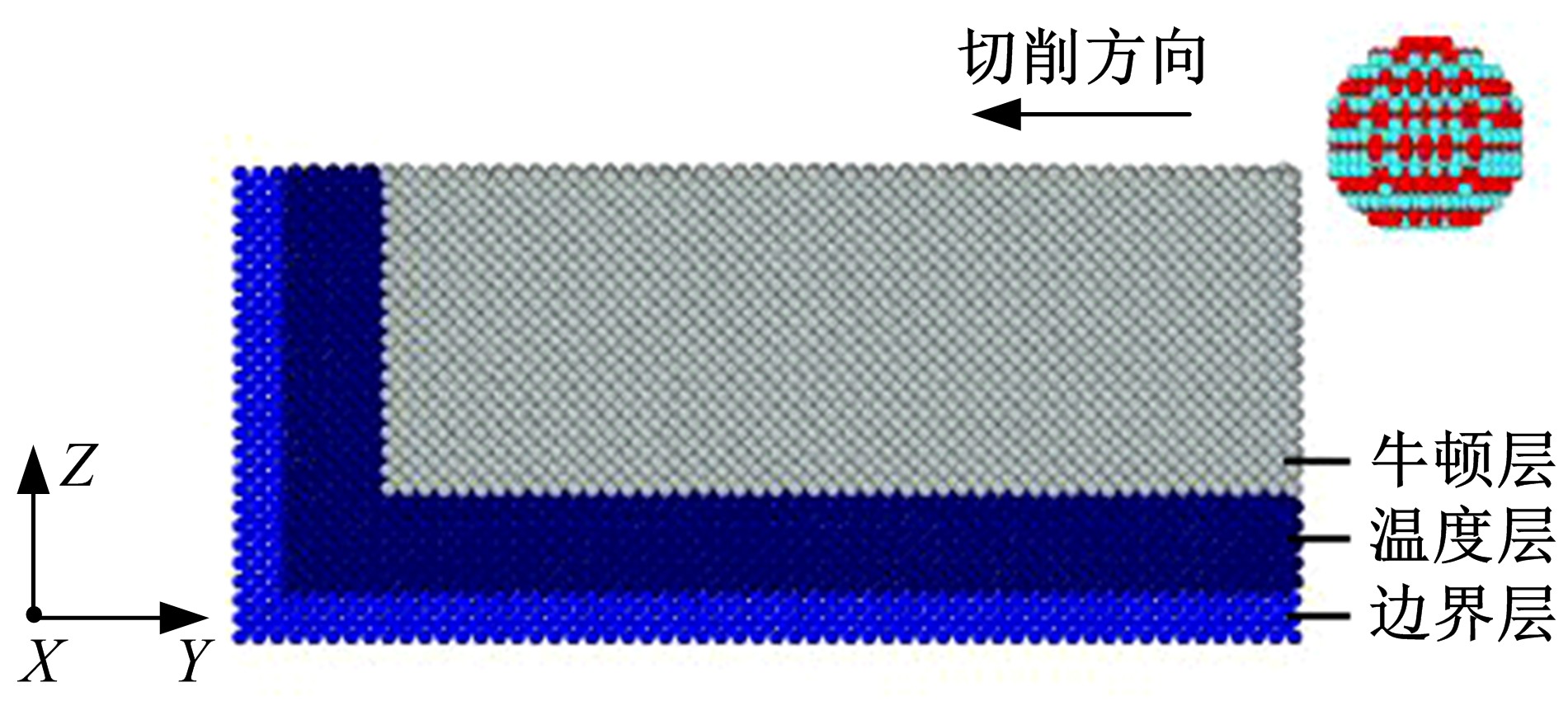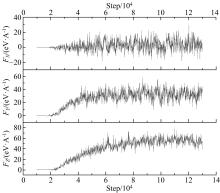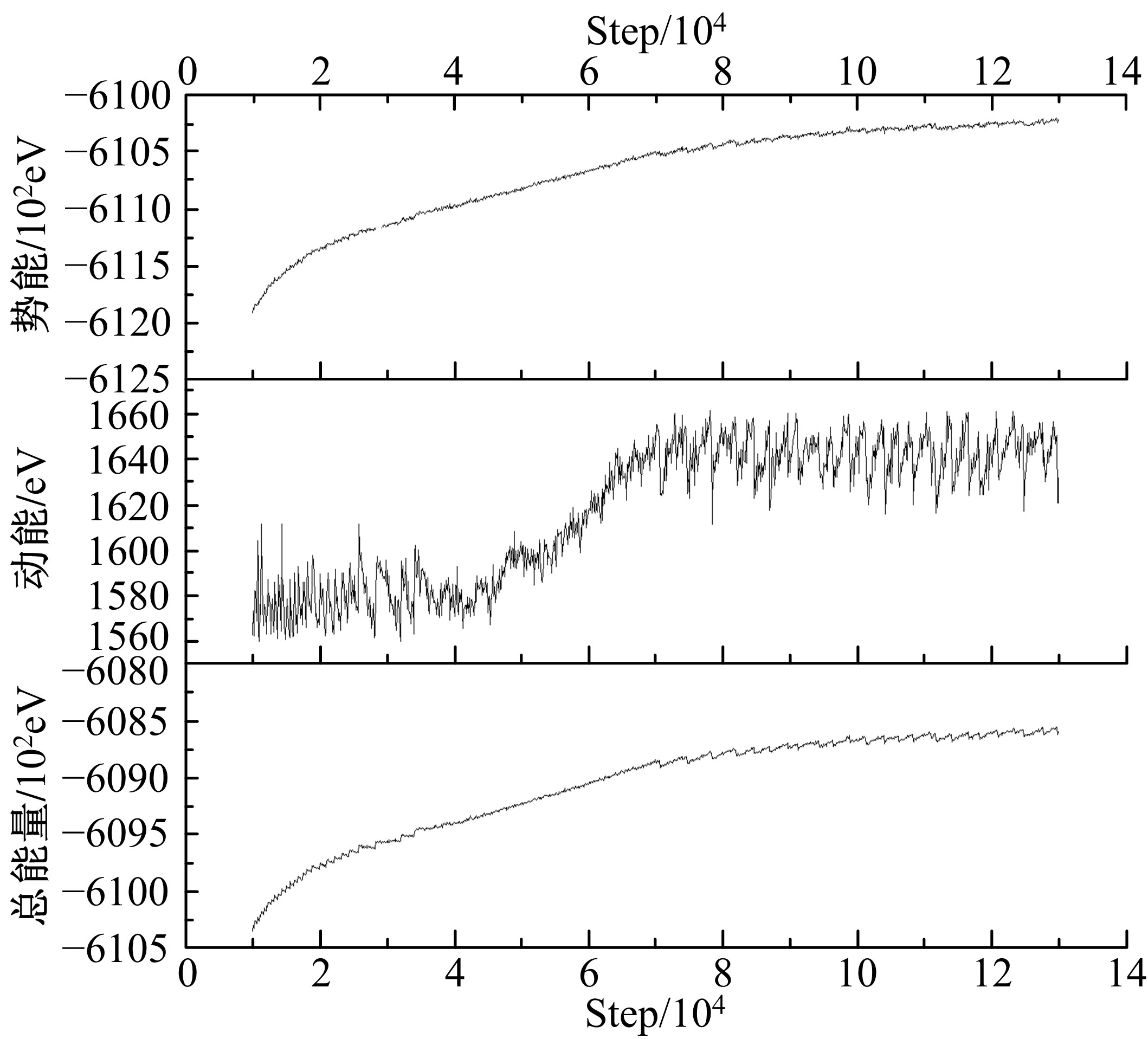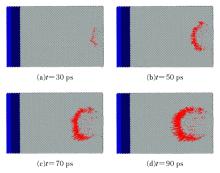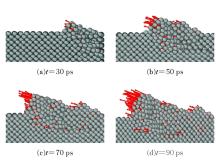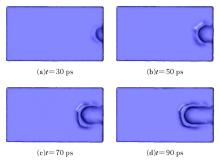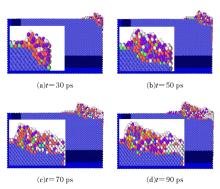吉林大学学报(工学版) ›› 2019, Vol. 49 ›› Issue (5): 1567-1574.doi: 10.13229/j.cnki.jdxbgxb20180623
• • 上一篇
基于分子动力学的磨粒微切削单晶铁数值分析
李俊烨1,2( ),刘洋1,卢慧1,孟文卿1,杨兆军2,张心明1(
),刘洋1,卢慧1,孟文卿1,杨兆军2,张心明1( )
)
- 1. 长春理工大学 跨尺度微纳制造教育部重点实验室,长春 130022
2. 吉林大学 机械与航空航天工程学院,长春 130022
Numerical analysis of single crystal Fe with abrasive grain micro-cutting based on molecular dynamics
Jun-ye LI1,2( ),Yang LIU1,Hui LU1,Wen-qing MENG1,Zhao-jun YANG2,Xin-ming ZHANG1(
),Yang LIU1,Hui LU1,Wen-qing MENG1,Zhao-jun YANG2,Xin-ming ZHANG1( )
)
- 1. Ministry of Education Key Laboratory for Cross-Scale Micro and Nano Manufacturing, Changchun University of Science and Technology, Changchun 130022, China
2. School of Mechanical and Aerospace Engineering, Jilin University, Changchun 130022, China
摘要:
为探讨磨粒流加工过程中工件材料去除机制,采用分子动力学方法模拟碳化硅颗粒微切削单晶铁的加工过程,研究磨粒微切削单晶铁过程中影响切削力变化的微观作用机制及切削力产生持续波动的原因,揭示磨粒微切削作用下工件材料发生物理变化的内在原因及磨粒对工件的做功规律。通过原子位移分析可知,磨粒微切削过程中材料的塑性变形主要是由晶格内滑移面上产生滑移区域从而形成位错,原子在切削力作用下沿位错线发生运动所导致,同时,探讨了原子的堆积现象及切屑形成机制。通过多面体模板匹配方法对微切削过程中工件原子排布情况进行了分析,探讨了工件材料内晶格结构的变化情况。本文研究可为磨粒流精密加工单晶铁工件材料提供理论基础和技术支持。
中图分类号:
- TG501
| 1 | 李俊烨, 乔泽民, 杨兆军, 等. 介观尺度下磨料浓度对磨粒流加工质量的影响[J]. 吉林大学学报: 工学版, 2017, 47(3): 837-843. |
| LiJun-ye, QiaoZe-min, YangZhao-jun, et al. Influence of abrasive concentration on processing quality of abrasive flow in mesoscopic scale[J]. Journal of Jilin University (Engineering and Technology Edition), 2017, 47(3): 837-843. | |
| 2 | 焦佳能, 费群星, 白凤民, 等. 钛合金表面磨粒流加工工艺研究[J]. 金刚石与磨料磨具工程, 2010, 30(1): 42-45. |
| JiaoJia-neng, FeiQun-xing, BaiFeng-min, et al. Surface finishing of titanium alloy component by abrasive flow machining[J]. Diamond and Abrasives Engineering, 2010, 30(1): 42-45. | |
| 3 | 丁金福, 刘润之, 张克华, 等. 磨粒流精密光整加工的微切削机理[J]. 光学精密工程, 2014, 22(12): 3324-3331. |
| DingJin-fu, LiuRun-zhi, ZhangKe-hua, et al. Micro cutting mechanism of abrasive flow precision machining[J]. Optics and Precision Engineering, 2014, 22(12): 3324-3331. | |
| 4 | 李俊烨, 胡敬磊, 杨兆军, 等. 离散相磨粒粒径对磨粒流研抛共轨管质量的影响[J]. 吉林大学学报: 工学版, 2018, 48(2): 492-499. |
| LiJun-ye, HuJing-lei, YangZhao-jun, et al. Effect on the quality of abrasive flow polishing the common rail pipe in size of discrete phase abrasive particle[J]. Journal of Jilin University (Engineering and Technology Edition), 2018, 48(2): 492-499. | |
| 5 | VenkateshG, SharmaA K, KumarP. On ultrasonic assisted abrasive flow finishing of bevel gears[J]. International Journal of Machine Tools & Manufacture, 2015, 89: 29-38. |
| 6 | 李俊烨, 董坤, 王兴华, 等. 颗粒微切削表面创成的分子动力学仿真研究[J]. 机械工程学报, 2016, 52(17): 94-104. |
| LiJun-ye, DongKun, WangXing-hua, et al. Molecular dynamics simulation research into generative mechanism of particles micro-cutting surface[J]. Journal of Mechanical Engineering, 2016, 52(17): 94-104. | |
| 7 | GoelS, KovalchenkoA, StukowskiA, et al. Influence of microstructure on the cutting behaviour of silicon[J]. Acta Materialia, 2015, 105: 464-478. |
| 8 | LiJ Y, MengW Q, DongK, et al. Study of effect of impacting direction on abrasive nanometric cutting process with molecular dynamics[J]. Nanoscale Research Letters, 2018, 13(1): 1-14. |
| 9 | WangQ, BaiQ, ChenJ, et al. Influence of cutting parameters on the depth of subsurface deformed layer in nano-cutting process of single crystal copper[J]. Nanoscale Research Letters, 2015, 10(1): 1-8. |
| 10 | 周晓勤, 朱志伟, 罗丹, 等. 线性改变切削深度对单晶铜纳米切削的影响[J]. 吉林大学学报: 工学版, 2012, 42(1): 109-115. |
| ZhouXiao-qin, ZhuZhi-wei, LuoDan, et al. Influence of linearly varying cutting depth on nanocutting of monocrystalline copper[J]. Journal of Jilin University (Engineering and Technology Edition), 2012, 42(1): 109-115. | |
| 11 | DawM S, BaskesM I. Embedded-atom method: derivation and application to impurities, surfaces, and other defects in metals[J]. Physical Review B, 1984, 29(12): 6443-6453. |
| 12 | GirifalcoL A, WeizerV G. Application of the morse potential function to cubic metals[J]. Physical Review, 1959, 114(3): 687-690. |
| 13 | TersoffJ. Modeling solid-state chemistry: interatomic potentials for multicomponent systems[J]. Physical Review B, 1989, 39(8): 5566-5568. |
| [1] | 曹恩国,刘坤,吉硕,孙震源,徐洪伟,骆星吉. 减重站起康复训练系统机械结构设计与优化[J]. 吉林大学学报(工学版), 2019, 49(5): 1558-1566. |
| [2] | 张艳芹,冯雅楠,孔鹏睿,于晓东,孔祥滨. 基于热油携带的静压支承油膜温度场及试验[J]. 吉林大学学报(工学版), 2019, 49(4): 1203-1211. |
| [3] | 杨成,赵永胜,刘志峰,蔡力钢. 基于多尺度理论的栓接结合部动力学建模[J]. 吉林大学学报(工学版), 2019, 49(4): 1212-1220. |
| [4] | 刘坤,吉硕,孙震源,徐洪伟,刘勇,赵静霞. 多功能坐站辅助型如厕轮椅机械结构设计与优化[J]. 吉林大学学报(工学版), 2019, 49(3): 872-880. |
| [5] | 王兴野,张进秋,李国强,彭志召. 惯性质量对齿轮齿条式作动器阻尼特性的影响[J]. 吉林大学学报(工学版), 2019, 49(3): 881-887. |
| [6] | 王家序,倪小康,韩彦峰,向果,肖科. 轴向往复运动下微槽轴承混合润滑数值模型[J]. 吉林大学学报(工学版), 2019, 49(3): 888-896. |
| [7] | 毕秋实,王国强,黄婷婷,毛瑞,鲁艳鹏. 基于DEM-FEM耦合的双齿辊破碎机辊齿强度分析[J]. 吉林大学学报(工学版), 2018, 48(6): 1770-1776. |
| [8] | 朱伟,王传伟,顾开荣,沈惠平,许可,汪源. 一种新型张拉整体并联机构刚度及动力学分析[J]. 吉林大学学报(工学版), 2018, 48(6): 1777-1786. |
| [9] | 刘建芳, 王记波, 刘国君, 李新波, 梁实海, 杨志刚. 基于PMMA内嵌三维流道的压电驱动微混合器[J]. 吉林大学学报(工学版), 2018, 48(5): 1500-1507. |
| [10] | 毛宇泽, 王黎钦. 鼠笼支撑一体化结构对薄壁球轴承承载性能的影响[J]. 吉林大学学报(工学版), 2018, 48(5): 1508-1514. |
| [11] | 孙秀荣, 董世民, 王宏博, 李伟成, 孙亮. 整体抽油杆柱在油管内空间屈曲的多段式仿真模型对比[J]. 吉林大学学报(工学版), 2018, 48(4): 1124-1132. |
| [12] | 王涛, 伞晓刚, 高世杰, 王惠先, 王晶, 倪迎雪. 光电跟踪转台垂直轴系动态特性[J]. 吉林大学学报(工学版), 2018, 48(4): 1099-1105. |
| [13] | 刘坤, 刘勇, 闫建超, 吉硕, 孙震源, 徐洪伟. 基于体外传感检测的人体站起动力学分析[J]. 吉林大学学报(工学版), 2018, 48(4): 1140-1146. |
| [14] | 吉野辰萌, 樊璐璐, 闫磊, 徐涛, 林烨, 郭桂凯. 基于MBNWS算法的假人胸部结构多目标优化设计[J]. 吉林大学学报(工学版), 2018, 48(4): 1133-1139. |
| [15] | 贺继林, 陈毅龙, 吴钪, 赵喻明, 汪志杰, 陈志伟. 起重机卷扬系统能量流动分析及势能回收系统实验[J]. 吉林大学学报(工学版), 2018, 48(4): 1106-1113. |
|
||

